Samsung Galaxy S7 Edge vs iPhone 6S Plus
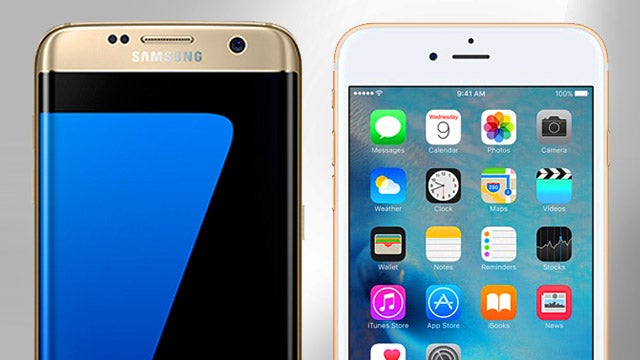
Has the Samsung Galaxy S7 Edge trumped the iPhone 6S Plus? We compare these two large-screened champions in an attempt to find out.
Samsung has taken steps to differentiate the Galaxy S7 Edge from the Galaxy S7. The result is a 5.5-inch phablet that sits firmly in iPhone 6S Plus territory.
So how do these two super-sized smartphones compare? Let’s take a look.
WATCH: Our in-depth S7 Edge video review
Samsung Galaxy S7 Edge vs iPhone 6S Plus: Design
Samsung Galaxy S7 Edge: 7.7mm thick, 157g, metal alloy, 3D thermoformed dual-curved display, IP68 certified, Black/Gold
iPhone 6S Plus: 7.3mm thick, 192g, series 7000 anodised aluminium back, Space Grey/Silver/Gold/Rose Gold
Last year’s Samsung Galaxy S6 Edge was arguably the best looking smartphone we’d ever seen. Samsung knew it was onto a good thing, and the Galaxy S7 Edge looks very similar indeed.
In fact, if anything, Samsung has improved the look of the new phone. Yes, it’s a little thicker than its predecessor, but its new curved back makes it nicer to hold, and the camera module no longer sticks out so conspicuously from the back. It still has that beautiful dual-curved display, too.
Related: Galaxy Note 6 release
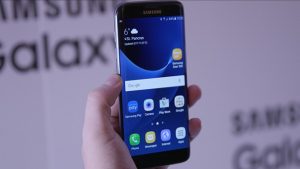
All of which means that the S7 Edge is a far better-looking phone than the iPhone 6S Plus. We’ve never been blown away by Apple’s current smartphone design template, which began with the iPhone 6 and 6 Plus, with its simple curves, ugly plastic antennae, and sticky-outy camera.
While the Galaxy S7 Edge is 0.4mm thicker than the iPhone 6S Plus, it’s 7mm shorter, 5mm narrower, and a not-inconsiderable 35g lighter.
Another notable design point with the Samsung Galaxy S7 Edge is the fact that it’s IP68 certified, which means it can survive an extended dip in a pool, and won’t allow dust into its inner workings.
Of course, Apple boosted the toughness of its own phone with the use of series 7000 anodised aluminium and an Ion-X glass screen. There have also been reports that it’s been sealed against water ingress, but we wouldn’t take that as a license to take it into the bath with you.
Samsung Galaxy S7 Edge vs iPhone 6S Plus: Screen
Samsung Galaxy S7 Edge: 5.5-inch Super AMOLED, 2,560 x 1,440, 534 ppi
iPhone 6S Plus: 5.5-inch LCD, 1,920 x 1,080, 401 ppi, 3D Touch
Both of these phones have 5.5-inch displays – and that’s where the similarities end.
The Samsung Galaxy S7 Edge’s screen is much sharper at 2560 x 1440 (QHD) versus the iPhone 6S Plus screen’s 1920 x 1080 (1080p). That makes for a pixel density of 534ppi for the Samsung and 401ppi for the Apple.
Is a QHD resolution necessary for a high-end mobile phone? No, it’s not necessary. But at this larger-than-average size, the difference in sharpness is certainly noticeable, and that’s a clear advantage for the Samsung.
Related: Galaxy S7 vs iPhone 6S
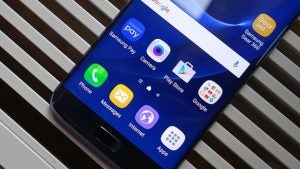
It’s not just on resolution that the Galaxy S7 Edge wins, either. It utilises Samsung’s latest Super AMOLED panel technology, which boasts better contrasts and more accurate colours than the iPhone 6S Plus’s LCD.
Make no mistake, the iPhone 6S Plus has one of the best LCD displays on the market. But our own view, and that of the display experts at DisplayMate, is that the Galaxy S7 Edge has one of the best displays of any kind.
It’s not perfect, though. We found the Galaxy S7 Edge display to have a strong blue tinge around its two edges, and viewing angles aren’t as good as on the iPhone. Outdoors viewability is also better on Apple’s handset.
Samsung Galaxy S7 Edge vs iPhone 6S Plus: Power
Samsung Galaxy S7 Edge: Exynos 8890 octa-core/Snapdragon 820 quad-core CPU, Adreno 530/Mali-T880 MP12 GPU, 4GB RAM
iPhone 6S Plus: Apple A9 64-bit dual-core 1.84GHz, PowerVR GT7600 GPU, 2GB RAM
Samsung has returned to a split CPU offering in the Samsung Galaxy S7 Edge, with most territories getting the Exynos 8 and some (chiefly the US) getting the Snapdragon 820. Some may find that disappointing after the Galaxy S6 range’s excellent custom Exynos 7 chip, but we’re talking about a major performance boost either way.
In real life usage, both are plenty fast, with a good 30 percent boost in CPU performance and 64 percent in GPU performance over the Exynos 7. When it comes to benchmark tests, the Exynos 8 seems to have the edge on multicore use, while the Snapdragon 820 takes the single-core crown.
So how does it stack up to the iPhone 6S Plus and its A9 CPU? It’s a mixed bag across the various benchmark tests, with multi-core performance understandably sharper on the quad-core Samsung and the iPhone taking the single-core win. Overall it seems as if performance is pretty much equal between the Exynos 8 and the Apple A9 CPU.
Related: Snapdragon 820 vs 810 vs 808

When it comes to RAM, the Galaxy S7 Edge has 4GB compared to the iPhone 6S Plus’s 2GB of RAM, but the true value of that extra memory isn’t clear-cut given the difference between Android and iOS.
What’s more, we have to say that the experience of using both shows the iPhone 6S Plus offers the smoother experience overall – but that can be put down to software matters rather than any hardware deficiency. We’ll discuss that more in the OS section.
Samsung Galaxy S7 Edge vs iPhone 6S Plus: Camera
Samsung Galaxy S7 Edge: 12-megapixel, phase detection, Dual Pixels, OIS, f/1.7 lens, 1/2.6″ sensor, 1.4 µm pixel, 4K video, 5-megapixel front camera
iPhone 6S Plus: 12-megapixel, phase detection, OIS, f/2.2 lens, 1/3″ sensor, dual LED ‘True Tone’ flash, 1.22 µm pixel, 4K video, 1.2-megapixel front camera
Samsung has rolled back the pixel count for the Galaxy S7 Edge camera, which means that it’s now level with the iPhone 6S Plus on 12-megapixels.
However, there’s a very good reason for that climb-down. Samsung has made those fewer pixels larger to the tune of 1.4 µm, which has the effect (when combined with a super-bright f/1.7 lens) of boosting photo brightness 95 percent over the Galaxy S6 Edge. The iPhone 6S Plus lens is only f/2.2, so it doesn’t let in as much light, and its pixels are only 1.22 µm in size.
Comparing the low light performance of these two phones bears this hardware advantage out. The Galaxy S7 Edge camera takes much brighter, clearer shots in tricky conditions than the iPhone 6S Plus.
Related: Galaxy S7 Price and Deals
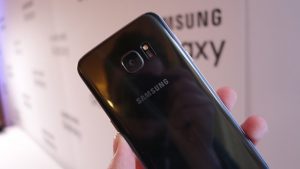
Autofocus on the Galaxy S7 Edge, too, is formidably fast. Thanks to Dual Pixel technology, the phone can lock on extremely quickly – it’s the best smartphone autofocus system we’ve ever seen. It stands to reason, then, that it’s much faster than the iPhone 6S Plus equivalent.
In daylight and decent lighting conditions, there’s much less of an advantage. In fact, we’d be tempted to give the edge to the iPhone 6S Plus for its reliability and colour accuracy.
As for the front cameras, there’s no contest. The Galaxy S7 Edge has a 5-megapixel sensor and a wide-angle f/1.7 lens, which means it takes much sharper and brighter selfies than the iPhone 6S Plus.
Samsung Galaxy S7 Edge vs iPhone 6S Plus: Features
Samsung Galaxy S7 Edge: Edge display, Samsung Pay
iPhone 6S Plus: 3D Touch, Apple Pay
Both smartphones make a song and dance over supposedly revolutionary screen technology, but in very different ways. The Samsung Galaxy S7 Edge has its dual-curved display, which melts away where the usual bezels should be.
To its credit, Samsung appears to have addressed criticisms of the gimmicky nature of this feature in last year’s Galaxy S6 Edge. This time around, there are a whole bunch of shortcuts and widgets that can be accessed through a swipe from the edge of the screen.
But we have to hand the advantage here to the iPhone 6S Plus. 3D Touch might not have become an essential part of everyday usage as we hoped it might, but it shows a lot of promise.
Related: iPhone 6S Plus vs iPhone 6S
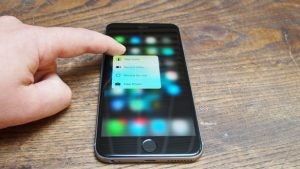
In case you’d forgotten, 3D Touch is a pressure-sensitive screen technology that debuted with the iPhone 6S and 6S Plus. Combined with related UI tweaks and a sophisticated haptic feedback motor, it enables a new layer of shortcuts and commands based on a firm press of the screen.
It needs deeper and more consistent integration – from Apple as well as app developers – but it remains a useful feature that will only get better over time.
Apple and Samsung have also imbued their latest phablets with the ability to make mobile payments. Both Apple Pay and Samsung Pay have clear strengths. Apple Pay is the more established, whereas Samsung Pay has the cleverer tech that lets you use it even with old fashioned card-scanning systems.
However, we have to give the nod to Apple here for being available in more places around the world, including the UK.
Samsung Galaxy S7 Edge vs iPhone 6S Plus: Storage
Samsung Galaxy S7 Edge: 32GB, microSD expansion
iPhone 6S Plus: 16GB / 64GB / 128GB
We have two vastly different approaches to storage here, and both have their strengths and flaws.
There’s only one fixed-storage option with the Samsung Galaxy S7 Edge, and that’s 32GB. This isn’t too bad, but when you consider that the added software bloat of the Samsung leaves you only around 20GB to play with, it doesn’t sound so great.
Of course, Samsung goes some way to addressing this with the reinstatement of microSD expansion.
Related: Best iPhone 6S Plus Deals
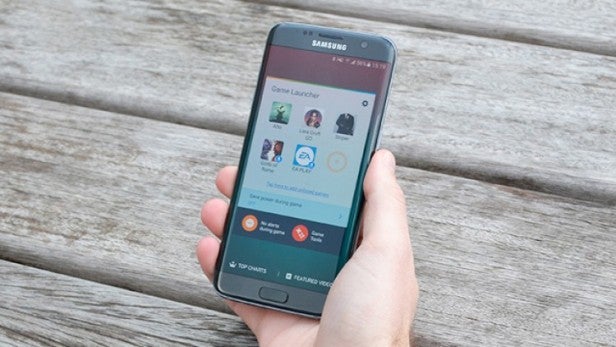
The iPhone 6S Plus doesn’t have that expansion option, of course. No Apple phone does. But it does offer more internal storage options. We particularly like the 64GB and 128GB options.
However, 16GB is simply inadequate for the modern smartphone, and should never have been offered up as an option.
Samsung Galaxy S7 Edge vs iPhone 6S Plus: OS
Samsung Galaxy S7 Edge: Android 6.0 Marshmallow, TouchWiz UI
iPhone 6S Plus: iOS 9
For all the Samsung Galaxy S7 Edge’s technical advantages over the iPhone 6S Plus, the iPhone 6S Plus still offers the better, smoother, and more intuitive software experience.
That’s because Apple’s hardware is perfectly in sync with its software. Say what you like about Apple’s conservative approach to software improvements – it’s slick, reliable, and it has the best app ecosystem out there.
Android 6.0 Marshmallow is formidable in its own way, of course, and it’s more advanced than iOS in many ways. But the thing with Samsung phones, as always, is that you don’t just get Android. You get Android plus Samsung’s needless TouchWiz UI.
Related: iPhone SE review
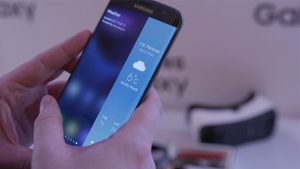
It’s gotten a lot better in recent years, of course, and Samsung also tends to optimise its UIs for large-screen devices better than Apple. But TouchWiz remains a pointless and sub-optimal reworking of Android overall.
We pick this out every year, but it goes beyond mere matters of personal preference. Despite the Galaxy S7 Edge’s impressive hardware, there remain niggling little bits of lag littered throughout TouchWiz. During our review period we would encounter the odd pause when opening up an app, and navigating through Samsung’s own efforts often leads to lengthy loading times.
To be honest, if Samsung had announced the option of stock Android with the Galaxy S7 Edge, we probably would have called it the overwhelming winner here. It didn’t, so we can’t.
Verdict
Samsung has created a beast of a super-sized smartphone in the Samsung Galaxy S7 Edge. In many ways, it has the measure of the iPhone 6S Plus, with a nicer design, superior screen, and a camera that operates better in low light conditions.
Unfortunately, it’s not quite simple enough to call this a clear win for Samsung, because iPhones tend to amount to more than the sum of their parts. Apple’s slick combination of software and hardware is seamless in a way that no Samsung phone has ever been – and the Galaxy S7 Edge hasn’t changed that.
If you want the latest and greatest phablet from a design and technological perspective, money no object, then we would give the clear edge (pun unintended) to the Samsung Galaxy S7 Edge. However, Apple’s peerless app ecosystem and slick iOS experience makes it an easier phone to live with day to day.
(apester:56b8b929180dad85056cdc9c)
Thanks to Three for lending us an iPhone 6S Plus for use in this article


